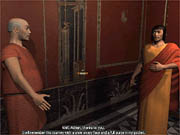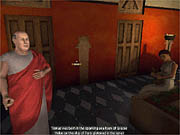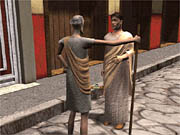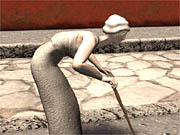When Mt. Vesuvius erupted in A.D. 79, it took just a few hours for the adjacent city of Pompeii to be destroyed. Unfortunately, that's also the approximate length of time it'll take veteran adventure gamers to finish Timescape: Journey to Pompeii, one of the latest historically inspired games from the dedicated adventure-game publisher Dreamcatcher Interactive.

Timescape was originally published in Europe by Cryo Interactive, whose many adventure games often lack an entirely coherent premise. Timescape is no exception. You play as Adrian Blake, presumably an archaeologist "on a mission for the crown" at the end of World War I. While exploring a cave, Adrian comes down with a fever and is approached by the goddess Ishtar, who offers to cure him in exchange for his love. Adrian refuses because he insists he loves only his fiancée Sophia, and so Ishtar decides to punish him for not believing in "love incarnate." Consequently, the night before Adrian's wedding back home, Sophia vanishes without a trace. Adrian returns to the cave region in search of Sophia, but it turns out his beloved is much farther away than he can imagine; she's been sent back in time to Pompeii and to the previous life she lived there. Ishtar sends Adrian back to the same time and gives him three days to locate Sophia and convince her to leave the city before the eruption occurs.

One of the first things you discover as Adrian is an amulet, which can be used at any point during play to access an extremely thorough encyclopedia. Here you'll find information on a myriad of topics about Pompeii, from its foundation and history to family life, religion, prominent citizens - even cooking, eroticism, and much more. None of the puzzles require you to dig through the encyclopedia for clues or answers, but the reading is interesting enough that you'll probably want to return to it even after you've completed the game.
Journey to Pompeii uses the same sort of first-person perspective and interface popularized by Myst and employed in countless other adventure games: You move between different preset points and can use the mouse to scan each of these scenes for clues and objects. The system works well for the most part, but it has its shortcomings--there are several points where you can overlook a necessary object because you forgot to look down at your feet or didn't move your mouse cursor over the exact hot spot. Exploration can be a little confusing at first because many streets have a similar appearance, which forces you to check the map constantly, not only to verify your location but also to ensure you're moving in the right direction.

Because of the interface and the fact that Timescape was developed by Arxel Tribe--the company that created such nonsensical and poorly designed adventure games as Ring: The Legend of the Nibelungen--you might initially expect Timescape to contain a few ridiculous puzzles scattered throughout barren environments. Fortunately, that's not the case at all: Timescape is definitely a traditional adventure game, with an emphasis on collecting inventory items and figuring out where and how to use them to overcome obstacles and to convince others to aid you in your quest. Though the streets of Pompeii seem a little deserted for a city of 10,000 to 15,000 inhabitants, you do get a chance to meet and interact with a decent number of characters. Conversation is handled via dialogue trees; most of the time you can simply click through each available subject until you've gleaned all possible information from a character, but other times your life depends on your choice of words. Death can come quickly in those cases, but afterward you're usually told where you went wrong, and it only takes a second or two to load a saved game.
While you'll appreciate the ability to interact with the denizens of Pompeii, you'll be greatly disappointed at the lack of character animations. Timescape certainly isn't the first adventure game to date in which the characters' mouths don't move when they speak; but what's more troubling is that most of the characters don't move at all during dialogue sequences. These frozen characters really detract from any sense of immersion the game manages to build up, especially when you juxtapose the stock-still characters and the energetically thick British accents of many of the actors who did the vocalizations.

Of course, it probably isn't reasonable to expect cutting-edge graphics and animations in a budget-priced game like Journey to Pompeii (it lists for $19.99 direct from Dreamcatcher). What's harder to understand is why the game is so short. It's not so much that the puzzles are too easy, though admittedly only a few will prove truly challenging for experienced players (and two of those are timed); it's that there simply aren't enough of them. Considering there are entire areas of the city that will remain unexplored by the game's finale, it seems only reasonable that the developer could have crammed a few more cardboard-cutout characters into those sections and given you a little more to do and see.
Timescape: Journey to Pompeii won't go down as a major achievement in the annals of adventure gaming, but then again it never really aspires to. What it does manage to do is keep you interested from start to finish, and if you can overlook the decidedly spartan production values, then that's probably enough to make it more than worth the asking price.